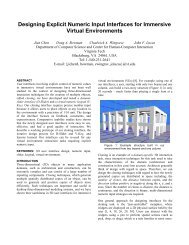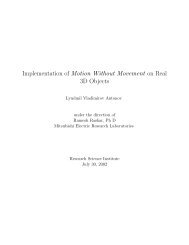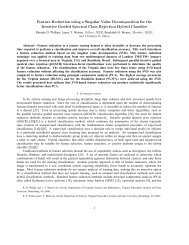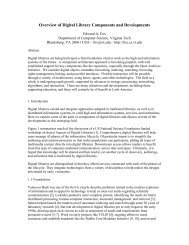A Case Study of Using Domain - Computer Science Technical ...
A Case Study of Using Domain - Computer Science Technical ...
A Case Study of Using Domain - Computer Science Technical ...
You also want an ePaper? Increase the reach of your titles
YUMPU automatically turns print PDFs into web optimized ePapers that Google loves.
IEEE TRANSACTIONS ON SOFTWARE ENGINEERING<br />
proposed [2]-[9] and surveyed [10]. In this study, we use the DARE: <strong>Domain</strong> analysis and reuse<br />
environment [4]. <strong>Using</strong> DARE, domain related information is collected in a domain book for the<br />
conflation algorithms domain.<br />
In information retrieval systems there is a need for finding related words to improve retrieval<br />
effectiveness. This is usually done by grouping words based on their stems. Stems are found by<br />
removing derivational and inflectional suffixes via stemming algorithms. The first affix removal<br />
stemming algorithm was developed by Lovins [12]. This algorithm did stemming by iteratively<br />
removing longest suffixes satisfying predefined suffix rules. Several other longest match affix<br />
removal algorithms have been developed since [13]-[17]. Porter algorithm [15],[16] is most<br />
commonly used because <strong>of</strong> its simplicity <strong>of</strong> implementation and compactness. Later Paice [17]<br />
proposed another compact algorithm. Hafer and Weiss [18] took a different approach in their<br />
successor variety stemming algorithm and proposed a word segmentation algorithm which used<br />
successor and predecessor varieties to determine fragmentation points for suffixes. Successor and<br />
predecessor varieties are the numbers <strong>of</strong> unique letters after and before a substring in a corpus.<br />
Their algorithm applied several rules to identify the stem from the substrings <strong>of</strong> each word that<br />
appeared in a corpus. The successor variety algorithm has the advantage <strong>of</strong> not requiring affix<br />
removal rules that are based the on the morphological structure <strong>of</strong> a language. However, the<br />
effectiveness <strong>of</strong> this algorithm depends on the corpus and on threshold values used in word<br />
segmentation. Adamson and Boreham [19] developed the N-gram algorithm that uses the<br />
number <strong>of</strong> distinct and common n-character substrings to determine if two or more corpus words<br />
can be conflated into the same group. Similar to successor variety, the strength <strong>of</strong> this algorithm<br />
depends on the corpus and the cut<strong>of</strong>f similarity value chosen. More recently, Krovetz [20]<br />
developed the K-stem algorithm that does a dictionary lookup after applying affix removal rules<br />
3












